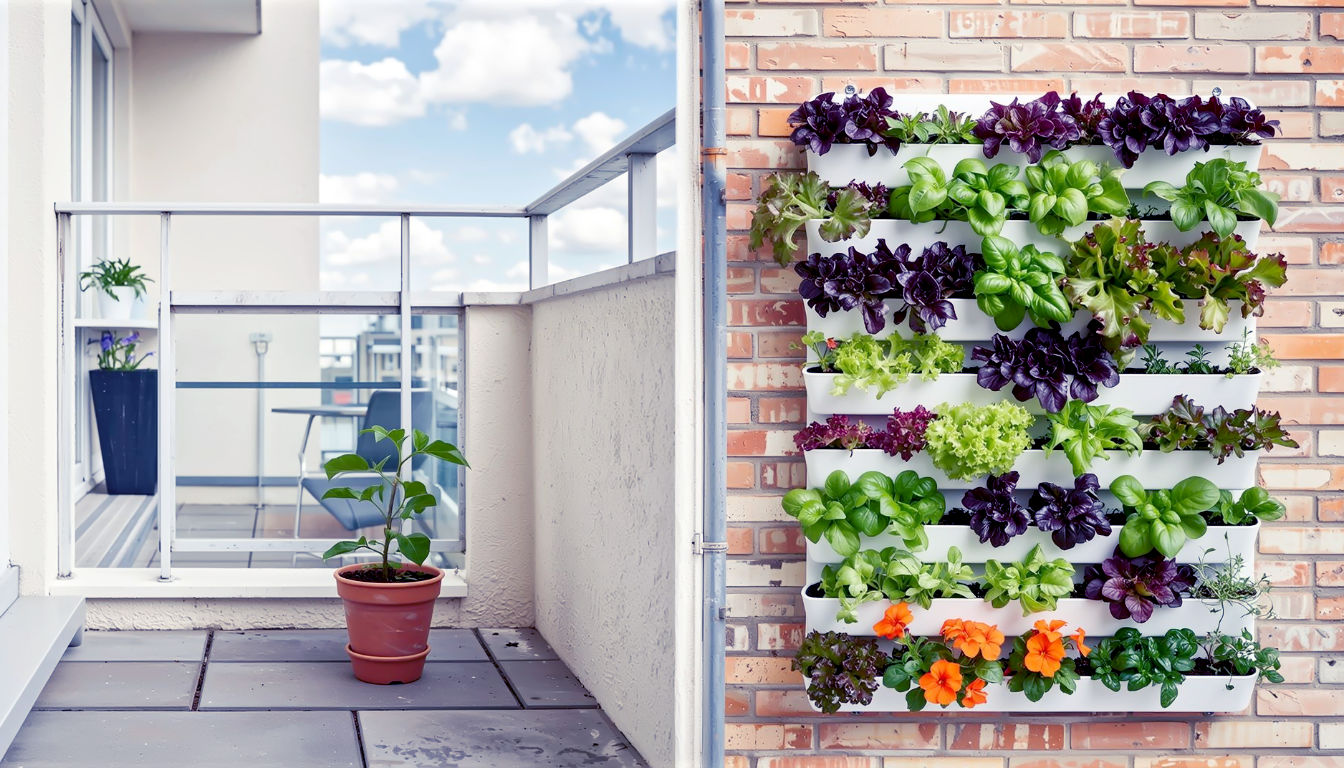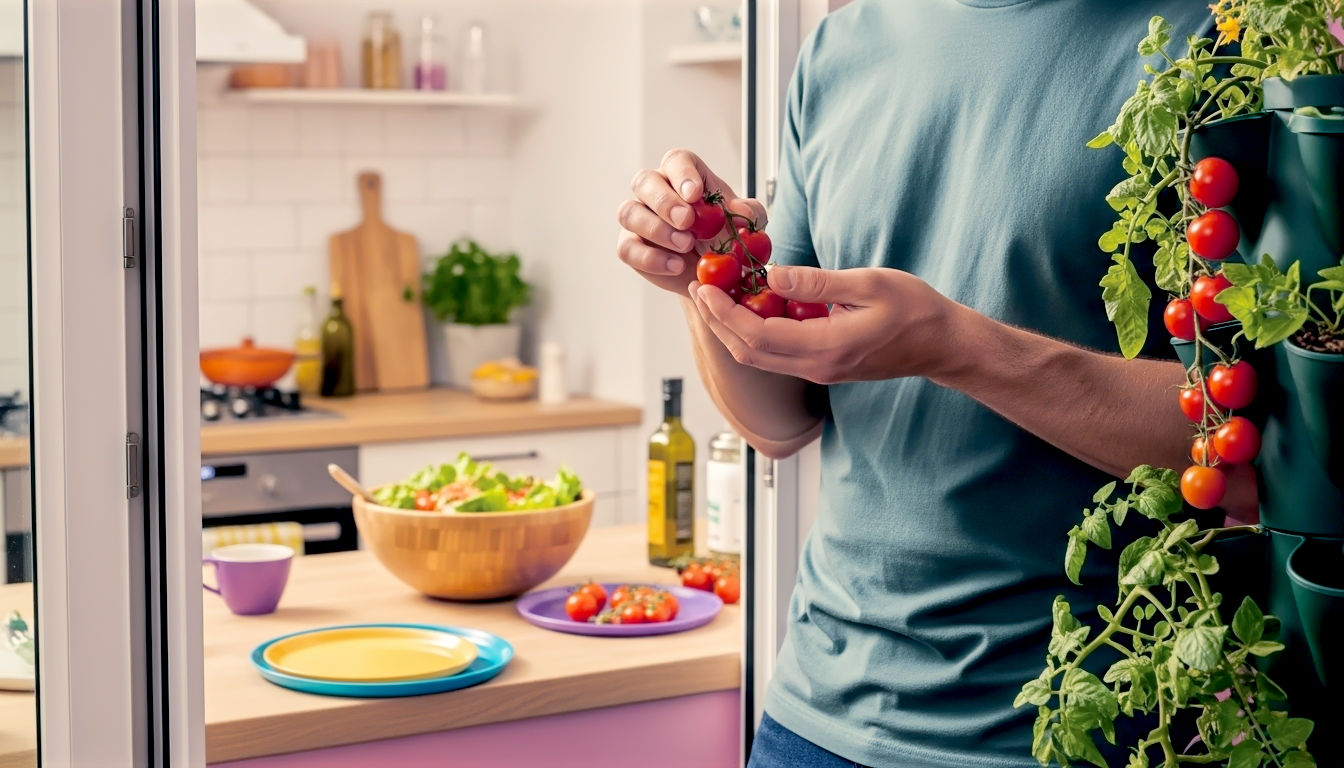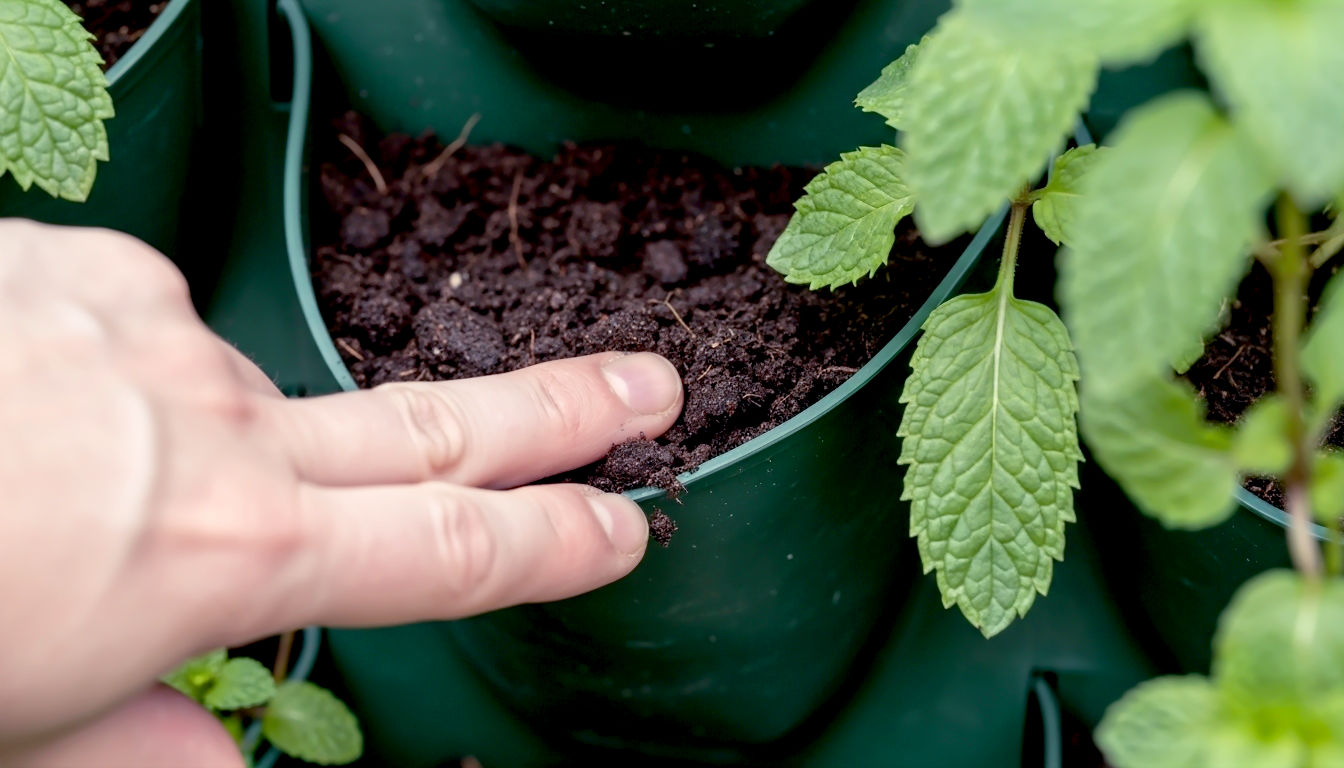The Guide to Vertical Gardening: Growing Up in Britain’s Urban Spaces
No garden? No problem. Discover how vertical gardening can turn any small urban space in Britain into a productive and beautiful green wall.

This post may contain affiliate links. If you make a purchase through these links, we may earn a commission at no additional cost to you.
Ever feel like your city home is bursting at the seams? You’ve got the postage-stamp-sized balcony, the tiny paved yard, or maybe just a lonely-looking window box. You dream of lush greenery, fresh herbs for your Sunday roast, and bright flowers to cheer up a grey British morning, but there’s simply no room. Or is there?
What if I told you that the problem isn’t a lack of space, but just how we look at it? We spend our lives thinking about floor space, about the square feet we live on. But we forget to look up. High above the concrete and the hustle and bustle lies a hidden garden, an untapped jungle of opportunity. This is the world of vertical gardening—a clever, creative, and surprisingly simple way to transform even the smallest urban nook into a thriving green oasis.
It’s not some futuristic concept from a sci-fi film. Vertical gardening is happening right now, on balconies in Bristol, along walls in Manchester, and in kitchens across London. It’s for anyone who wants to grow their own food, connect with nature, or just make their corner of the world a bit more beautiful. It’s about turning bland, boring walls into living, breathing works of art. Forget sprawling country estates; the future of British gardening is looking up. So, grab a cuppa, get comfortable, and let’s explore how you can join the urban growing revolution.
What on Earth Is Vertical Gardening?
Let’s get one thing straight: vertical gardening isn’t complicated. At its heart, it’s just growing plants upwards instead of outwards. Think of it like a bookshelf for your plants. Instead of spreading them across the floor, you stack them neatly on top of each other, using walls, fences, or special frames.

This simple idea is a game-changer for anyone living in a town or city. When ground space is as rare as a sunny bank holiday weekend, building up is the only way to go. It allows you to cultivate a surprising number of plants—from herbs and salad leaves to strawberries and flowers—in a ridiculously small footprint.
Imagine a bare brick wall on your balcony. Now, picture that same wall covered in cascading tomato vines, fragrant basil, and cheerful marigolds. That’s the magic of vertical gardening. It’s about taking unused, vertical surfaces and turning them into productive, beautiful green spaces.
The Simple Science Behind It
You might be wondering how plants can possibly grow sideways out of a wall. Don’t they need deep soil to put down roots? Well, yes and no.
In a traditional garden, plants send their roots deep into the ground to find water and nutrients. In a vertical garden, we give them everything they need in a much smaller package. Instead of a vast expanse of soil, each plant gets its own little pocket or pot, filled with high-quality compost.
There are lots of different ways to do this, from simple stacking pots to clever high-tech systems. But the basic principle is the same: give the roots a cosy home with enough soil, water, and food, and they’ll happily grow just about anywhere. It’s less about the direction they grow in and more about what you provide them with.
A Potted History: How Gardening Reached for the Sky
The idea of growing upwards isn’t brand new. In fact, its roots stretch back thousands of years. The most famous example is the legendary Hanging Gardens of Babylon, one of the Seven Wonders of the Ancient World. Built around 600 BC, these gardens were said to be a breathtaking series of terraced rooftops and cascading vines, creating a man-made mountain of greenery in the middle of a desert. While we don’t know for sure if they were real, the story planted a seed—the idea that gardens could defy gravity.
Fast forward a few thousand years, and people were still finding clever ways to grow in tight spots. Think of the classic strawberry pot, with its little pockets on the sides, or ivy-covered cottage walls. These were early, simple forms of vertical gardening.
The Modern Green Wall is Born
The true pioneer of modern vertical gardening was a French botanist named Patrick Blanc. In the 1980s, he was wandering through tropical rainforests and noticed something fascinating. Many plants, like orchids and bromeliads, weren’t growing in the soil at all. They were clinging to tree trunks and cliff faces, getting all the water and nutrients they needed from the air and rain.
This gave him a brilliant idea. If plants could thrive on a vertical surface in nature, why not in a city?
Blanc developed a system he called Le Mur Végétal, or “The Plant Wall.” It involved a metal frame, a waterproof plastic sheet, and a layer of special felt. Plants were tucked into pockets in the felt, and a network of hidden tubes dripped water and nutrients down from the top. It was like creating a man-made cliff face for plants to live on.
His first major project, at the Museum of Science and Industry in Paris in 1986, was a sensation. People were amazed by this living, breathing wall of plants. Since then, his stunning “green walls” have appeared on buildings all over the world, from fancy hotels to office blocks, including London’s Athenaeum Hotel and the iconic one at the Westfield shopping centre. Patrick Blanc showed the world that a wall wasn’t just a wall—it could be a garden.
Why Should You Bother? The Brilliant Benefits of Going Up
So, it looks cool, but is vertical gardening really worth the effort? Absolutely. The benefits go way beyond just having a pretty wall. It can genuinely make your life—and your city—a little bit better.

1. It Saves an Incredible Amount of Space
This is the big one. For city dwellers, space is the ultimate luxury. A vertical garden lets you grow a feast in the same footprint a single large pot would take up. You can have a herb garden, a salad bar, and a flower patch all on one small balcony wall. It’s the gardening equivalent of turning a studio flat into a country manor. For anyone with a tiny yard, a balcony, or just a sunny wall, it’s a total game-changer.
2. Grow Your Own Fresh, Healthy Food
There’s nothing quite like snipping fresh herbs for your cooking or picking your own sun-ripened strawberries. The taste is worlds away from the stuff you buy in plastic packets at the supermarket. With a vertical garden, you can have a constant supply of fresh, organic produce right outside your door. It’s healthier for you and, because there are zero food miles involved, it’s much better for the planet too. You can grow:
- Herbs: Basil, mint, parsley, rosemary, thyme, chives.
- Salad Leaves: Lettuce, rocket, spinach, mizuna.
- Fruiting Plants: Strawberries, cherry tomatoes, chillies.
- Edible Flowers: Nasturtiums, violas, calendula.
3. It’s Easier on Your Back
Traditional gardening can be back-breaking work. All that bending, digging, and kneeling can take its toll. With a vertical garden, everything is at a comfortable height. Planting, watering, and harvesting are all done standing up. It makes gardening accessible to everyone, including older people or those with mobility issues. No more muddy knees!
4. Fewer Pests and Diseases
Because your plants are up off the ground, they’re much harder for common garden pests like slugs and snails to reach. While you might still get the odd aphid, the big battles are often avoided. The good air circulation around the plants also helps to prevent fungal diseases like mildew, which can be a real problem in damp British weather.
5. Greening Our Grey Cities
Vertical gardens do more than just look pretty. They are tiny, hardworking ecosystems. Plants absorb carbon dioxide and release oxygen, helping to clean the air we breathe. A wall covered in plants can also help to insulate a building, keeping it cooler in the summer and a bit warmer in the winter, which can save on energy bills. They absorb rainwater, reducing runoff into our overloaded drainage systems, and provide a much-needed habitat for bees and other pollinators in the concrete jungle. Every little green wall helps to make our cities healthier, more sustainable places to live.
Your Toolkit: Choosing the Right Vertical Gardening System
Okay, you’re sold on the idea. But where do you start? There are loads of different vertical gardening systems out there, from simple DIY projects to fancy automated kits. The best one for you will depend on your space, your budget, and what you want to grow.
Let’s break down the main types.
1. Pocket Planters
This is one of the simplest and most popular ways to start. Pocket planters are sheets of sturdy, breathable fabric (usually made from recycled plastic bottles) with multiple pockets sewn onto them. You just hang the sheet on a sunny wall or fence and fill each pocket with compost and a plant.
- Best for: Herbs, salad leaves, strawberries, and flowers like petunias or pansies.
- Pros: Cheap, easy to install, lightweight, great for beginners.
- Cons: The pockets can be quite small, so they dry out quickly in sunny weather. You’ll need to water them often.
- Top Tip: Choose a planter made from a thick, felt-like material. It will hold water better than thin, plastic-y versions.
2. Stacking Planters
Imagine a set of specially designed plant pots that stack securely on top of each other, creating a tower of green. That’s a stacking planter. Each level has space for several plants, and when you water the top pot, the excess water cleverly drips down to water the ones below.
- Best for: Plants that don’t need huge amounts of root space, like strawberries, herbs, and lettuce. They are brilliant for creating a compact strawberry patch on a patio.
- Pros: Space-efficient, water-saving design, easy to assemble.
- Cons: The lower levels can get less light, so you might need to rotate the tower every now and then.
- Top Tip: Look for a tower with a “worm tea” collector at the bottom. As water trickles through, it collects nutrients, creating a fantastic liquid fertiliser you can reuse.
3. Wall-Mounted Pots and Containers
This is a really flexible approach. It simply involves fixing individual pots, troughs, or containers onto a wall or fence. You can use special brackets to hang standard pots, or you can buy modular systems with containers that clip onto a backing panel. The great thing is you can arrange them however you like, creating your own unique design.
- Best for: Almost anything! Because you can choose different-sized pots, you can grow larger plants like dwarf beans, cherry tomatoes, or even small shrubs.
- Pros: Very versatile, allows you to grow a wide variety of plants, you can easily move or replace individual pots.
- Cons: Can be more expensive and time-consuming to set up than pocket planters. You’ll need to be confident with a drill!
- Top Tip: Get creative with your containers! You can upcycle old tin cans, plastic bottles, or wooden crates to create a quirky, eco-friendly display. Just make sure they have drainage holes.
4. Trellises and Climbing Frames
This is vertical gardening in its most traditional form. A trellis is simply a framework of wood or metal that you fix to a wall for climbing plants to scramble up. It’s a fantastic way to cover a large, ugly wall or fence with beautiful flowers or productive veg.
- Best for: Climbing plants like sweet peas, climbing roses, jasmine, clematis, beans, peas, and climbing squashes.
- Pros: Relatively cheap and easy to install, perfect for adding height and drama to a garden, provides great coverage.
- Cons: Only suitable for climbing plants, and you’ll need to spend some time training the plants to grow up the frame.
- Top Tip: Install the trellis a few inches away from the wall. This allows air to circulate behind the plants, which helps prevent disease and stops moisture from getting trapped against the brickwork.
5. Hydroponic Systems
Now we’re getting into the high-tech stuff. Hydroponics is a method of growing plants without any soil. Instead, their roots are bathed in a nutrient-rich water solution. Vertical hydroponic systems usually look like towers or panels with holes for the plants. A pump circulates the water from a reservoir at the bottom up to the top, where it trickles down over the plants’ roots.
- Best for: Leafy greens like lettuce and spinach, and herbs like basil. These plants grow incredibly quickly in hydroponic systems.
- Pros: Very water-efficient (uses up to 90% less water than soil gardening), faster growth, no soil means no soil-borne pests or diseases.
- Cons: Can be expensive to buy, requires electricity to run the pump, and you need to get the nutrient mix just right. It’s more for the keen gadget-lover.
- Top Tip: Start with a small, all-in-one kit. This takes the guesswork out of setting it up and is a great way to learn the basics of hydroponics.
Getting Your Hands Dirty: A Step-by-Step Guide
Ready to build your own slice of paradise? Here’s a simple guide to getting started. We’ll focus on a pocket planter system, as it’s one of the easiest and most rewarding for beginners.

Step 1: Choose Your Location
This is the most important decision you’ll make. Most plants, especially fruit and veg, need a decent amount of sunlight to thrive.
- Find the Sun: Spend a day watching how the sun moves across your space. You’re looking for a spot that gets at least 4-6 hours of direct sunlight a day. South-facing walls are perfect. East- or west-facing walls are also good. North-facing walls are much trickier and are best for shade-loving plants like ferns and hostas.
- Check the Wall: Make sure the wall or fence you plan to use is strong enough to hold the weight of the planter once it’s full of wet compost and plants. A solid brick wall or sturdy wooden fence is ideal. Avoid old, crumbly walls.
- Think About Water: Is there a tap nearby? Or will you have to lug a heavy watering can through your house? Position your garden somewhere that’s easy to water.
Step 2: Gather Your Gear
You don’t need much to get started.
- Your Planter: A fabric pocket planter. Choose a size that fits your space.
- The Right Compost: This is crucial. The small pockets dry out fast, so you need a compost that holds onto moisture. A good quality, peat-free multi-purpose compost with some added water-retaining granules is perfect. Avoid cheap, poor-quality stuff; it’s a false economy.
- Your Plants: Choose small, young plants (often called plug plants) from a garden centre or online. They are easier to handle and establish better than larger plants.
- A Trowel: A small hand trowel will make filling the pockets much easier.
- Watering Can: One with a long spout or a ‘rose’ attachment is best for gentle watering.
Step 3: Planting Up
Now for the fun part!
- Hang Your Planter: Follow the manufacturer’s instructions to securely fix the planter to the wall. Make sure it’s level.
- Prepare the Compost: In a bucket or large tub, mix your compost with a handful of water-retaining granules and, if you like, a slow-release fertiliser. This will give your plants a great start in life.
- Fill the Pockets: Start at the top and fill each pocket with your compost mix. Don’t pack it in too tightly.
- Pop in the Plants: Gently remove each plant from its pot. Tease out the roots a little if they are tightly coiled. Make a small hole in the compost, pop the plant in, and firm the compost around it.
- Water Well: Once all the plants are in, give the whole thing a thorough but gentle watering. Water each pocket until you see drips coming from the bottom.
Step 4: Caring for Your Vertical Garden
Your garden is alive! Now you just need to keep it happy.
- Water, Water, Water: This is the golden rule of vertical gardening. Those small pockets can dry out in a flash, especially on a warm, windy day. Check the compost every day by sticking your finger in. If it feels dry, it’s time to water. You might need to water every day in the height of summer.
- Feed Your Plants: The compost only has enough nutrients to last a few weeks. To keep your plants growing strong, you’ll need to feed them. A liquid seaweed or tomato feed, diluted in your watering can every two weeks, is perfect.
- A Little TLC: Snip off any dead or yellowing leaves to keep the plants healthy. Harvest your herbs and salad leaves regularly—the more you pick, the more they’ll grow. Keep an eye out for pests like greenfly and squish them with your fingers or use a simple soap spray.
What to Grow? The Best Plants for a British Vertical Garden
Not all plants are created equal when it comes to growing upwards. You need plants that are happy in small spaces and can cope with the conditions. Here are some tried-and-tested winners for the UK climate.
Top Tier: The Easiest Plants for Beginners
- Lettuce and Salad Leaves: ‘Cut-and-come-again’ varieties are brilliant. You can snip off the outer leaves for a salad, and the plant will keep producing more from the centre.
- Herbs: Most herbs love the good drainage of a vertical garden. Mint, chives, thyme, marjoram, and parsley are all super easy. Basil loves a sunny, sheltered spot.
- Strawberries: An absolute classic. The fruits hang down away from the soil, which keeps them clean and helps prevent them from rotting.
- Nasturtiums: These cheerful flowers are a triple threat. They look beautiful, the flowers and leaves are edible (they have a peppery taste, great in salads), and they attract bees.
Next Level: For the More Ambitious Gardener
- Cherry Tomatoes: Choose a compact, trailing variety like ‘Tumbling Tom’. They will need regular feeding and consistent watering, but the taste of a homegrown tomato is your reward.
- Chillies and Peppers: These love a hot, sunny spot. A south-facing wall is ideal. They’ll need a slightly bigger pocket or pot.
- Dwarf French Beans: Look for compact or climbing varieties. They are surprisingly productive in a vertical garden.
- Flowers: Trailing flowers like petunias, lobelia, and verbena will create a stunning cascade of colour. Marigolds are great for adding a splash of orange and are said to deter pests.
Shady Characters: Plants for North-Facing Walls
Don’t despair if your only available wall is a bit gloomy. You can still grow things!
- Ferns: Many ferns thrive in shady, damp conditions and look wonderfully lush and green.
- Hostas: Known for their beautiful architectural leaves.
- Herbs: Mint and chives will tolerate a bit of shade.
- Spinach: This leafy green doesn’t mind cooler, shadier spots.
Common Problems and How to Solve Them
Even the greenest-fingered gardener runs into trouble sometimes. Here are a few common vertical gardening hiccups and how to fix them.

- Problem:“My plants keep drying out!”
- Solution: This is the number one issue. First, make sure you’re using a good moisture-retentive compost with water-retaining granules. Second, check your plants every single day, especially in summer. If you go away for a weekend, you might need to set up a simple drip irrigation system or ask a neighbour to water for you.
- Problem:“The plants at the bottom seem weak and leggy.”
- Solution: This is usually due to a lack of light, either because the top plants are shading them or because the wall itself is in a shady spot. Try to arrange your plants so the tallest ones are at the bottom and the shorter, trailing ones are at the top. If you’re using a stacking planter, rotate it every few days.
- Problem:“My plants have been attacked by greenfly!”
- Solution: Pests can still find their way up a wall. The best defence is to check your plants regularly. If you spot a few aphids, you can simply wipe them off with your fingers. For a bigger infestation, spray the plants with a solution of water and a few drops of washing-up liquid. You can also try planting marigolds or chives among your other plants, as their smell can help to repel pests.
- Problem:“Everything looked great for a few months, but now it looks tired.”
- Solution: The small amount of compost in vertical planters runs out of steam faster than in a traditional garden. Regular feeding every couple of weeks is essential during the growing season (spring and summer). Also, don’t be afraid to refresh your display. As summer salad leaves finish, you could replace them with winter greens or violas for some autumn colour.
The Future is Green: Vertical Farming and Beyond
Vertical gardening isn’t just for balconies and backyards. On a much larger scale, it’s a technology that could help shape the future of how we feed our cities.
Vertical farming takes the same principles—growing upwards in stacked layers—and applies them in huge, controlled indoor environments. Imagine a warehouse in the middle of a city, where shelves of lettuce, herbs, and strawberries stretch up to the ceiling. Instead of sunlight, they are bathed in the pinkish glow of specialised LED lights. Their roots are fed by hydroponic or aeroponic (misting) systems.
This might sound like science fiction, but it’s already happening. Companies in the UK and around the world are building these high-tech farms to grow food right where it’s needed most.
The benefits are huge. By controlling the environment, you can grow crops all year round, whatever the British weather is doing outside. It uses far less water than traditional farming and, because there are no pests indoors, there’s no need for pesticides. And by growing in the city, you slash the food miles, meaning fresher food and lower carbon emissions.
It won’t replace traditional farming, but for certain crops, it offers a sustainable, reliable way to feed a growing urban population. What you do on your balcony is a small, personal version of a much bigger idea—an idea that could help make our cities greener, healthier, and more resilient for the future.
Your little wall of green is more than just a garden. It’s a statement. It’s a vote for fresh food, for cleaner air, for a connection to nature in a world of concrete and steel. It’s a small act of rebellion against the idea that you need a sprawling lawn to be a gardener. So find a wall, get planting, and start your own upwardly mobile growing adventure.
Further Reading & Resources
For those looking to dig deeper, here are some of the most respected British resources for gardeners:
- Royal Horticultural Society (RHS): The UK’s leading gardening charity, their website is an encyclopaedia of reliable gardening advice. www.rhs.org.uk
- Gardeners’ World: The BBC’s flagship gardening programme and magazine. Their website is packed with practical tips and seasonal advice. www.gardenersworld.com
- Vertical Veg: An excellent resource from Mark Ridsdill Smith, who documents his experience of growing a huge amount of food on his London balcony. Inspiring and practical. www.verticalveg.org.uk
- Garden Organic: The UK’s leading organic growing charity. They offer fantastic advice on growing without chemicals. www.gardenorganic.org.uk






